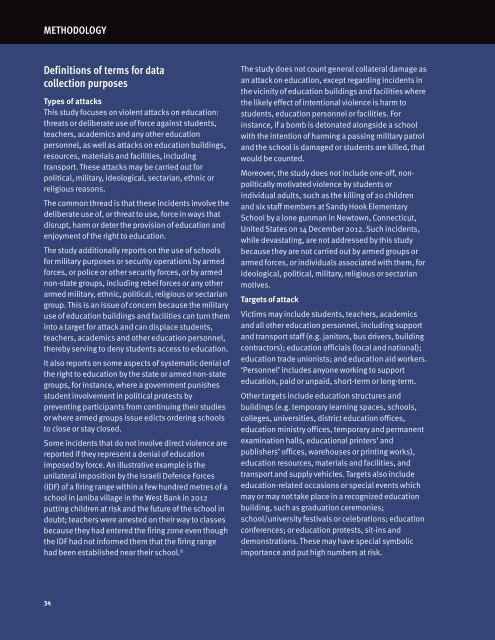Create successful ePaper yourself
Turn your PDF publications into a flip-book with our unique Google optimized e-Paper software.
MeTHODOLOGY<br />
Definitions of terms for data<br />
collection purposes<br />
Types of attacks<br />
This study focuses on violent attacks on education:<br />
threats or deliberate use of force against students,<br />
teachers, academics and any other education<br />
personnel, as well as attacks on education buildings,<br />
resources, materials and facilities, including<br />
transport. These attacks may be carried out for<br />
political, military, ideological, sectarian, ethnic or<br />
religious reasons.<br />
The common thread is that these incidents involve the<br />
deliberate use of, or threat to use, force in ways that<br />
disrupt, harm or deter the provision of education and<br />
enjoyment of the right to education.<br />
The study additionally reports on the use of schools<br />
for military purposes or security operations by armed<br />
forces, or police or other security forces, or by armed<br />
non-state groups, including rebel forces or any other<br />
armed military, ethnic, political, religious or sectarian<br />
group. This is an issue of concern because the military<br />
use of education buildings and facilities can turn them<br />
into a target for attack and can displace students,<br />
teachers, academics and other education personnel,<br />
thereby serving to deny students access to education.<br />
It also reports on some aspects of systematic denial of<br />
the right to education by the state or armed non-state<br />
groups, for instance, where a government punishes<br />
student involvement in political protests by<br />
preventing participants from continuing their studies<br />
or where armed groups issue edicts ordering schools<br />
to close or stay closed.<br />
Some incidents that do not involve direct violence are<br />
reported if they represent a denial of education<br />
imposed by force. An illustrative example is the<br />
unilateral imposition by the Israeli Defence Forces<br />
(IDF) of a firing range within a few hundred metres of a<br />
school in Janiba village in the West Bank in 2012<br />
putting children at risk and the future of the school in<br />
doubt; teachers were arrested on their way to classes<br />
because they had entered the firing zone even though<br />
the IDF had not informed them that the firing range<br />
had been established near their school. 6<br />
The study does not count general collateral damage as<br />
an attack on education, except regarding incidents in<br />
the vicinity of education buildings and facilities where<br />
the likely effect of intentional violence is harm to<br />
students, education personnel or facilities. For<br />
instance, if a bomb is detonated alongside a school<br />
with the intention of harming a passing military patrol<br />
and the school is damaged or students are killed, that<br />
would be counted.<br />
Moreover, the study does not include one-off, nonpolitically<br />
motivated violence by students or<br />
individual adults, such as the killing of 20 children<br />
and six staff members at Sandy Hook Elementary<br />
School by a lone gunman in Newtown, Connecticut,<br />
United States on 14 December 2012. Such incidents,<br />
while devastating, are not addressed by this study<br />
because they are not carried out by armed groups or<br />
armed forces, or individuals associated with them, for<br />
ideological, political, military, religious or sectarian<br />
motives.<br />
Targets of attack<br />
Victims may include students, teachers, academics<br />
and all other education personnel, including support<br />
and transport staff (e.g. janitors, bus drivers, building<br />
contractors); education officials (local and national);<br />
education trade unionists; and education aid workers.<br />
‘Personnel’ includes anyone working to support<br />
education, paid or unpaid, short-term or long-term.<br />
Other targets include education structures and<br />
buildings (e.g. temporary learning spaces, schools,<br />
colleges, universities, district education offices,<br />
education ministry offices, temporary and permanent<br />
examination halls, educational printers’ and<br />
publishers’ offices, warehouses or printing works),<br />
education resources, materials and facilities, and<br />
transport and supply vehicles. Targets also include<br />
education-related occasions or special events which<br />
may or may not take place in a recognized education<br />
building, such as graduation ceremonies;<br />
school/university festivals or celebrations; education<br />
conferences; or education protests, sit-ins and<br />
demonstrations. These may have special symbolic<br />
importance and put high numbers at risk.<br />
34



